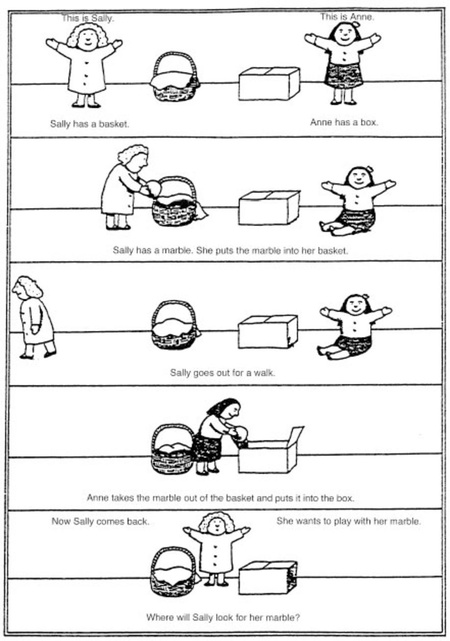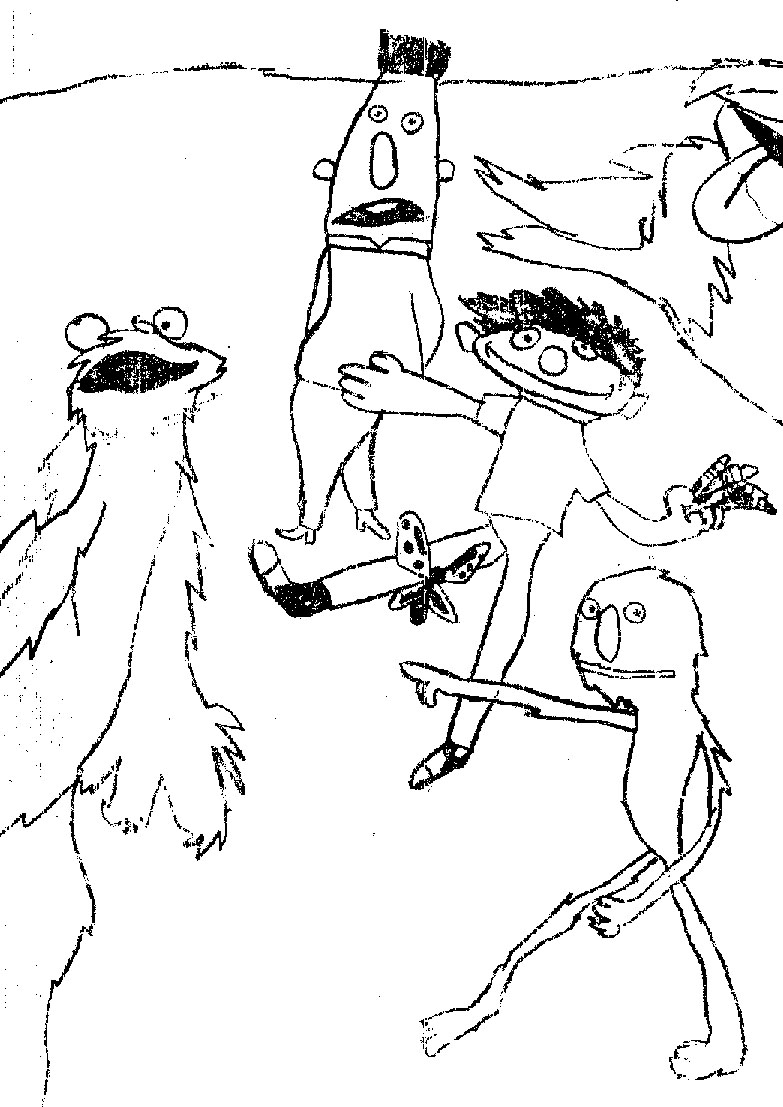Copyright © 2007-2018 Russ Dewey
Autism
Autism is a developmental disorder that produces a distinctive syndrome or pattern of symptoms. Once regarded as rare, autism is being diagnosed much more often in recent decades.
In the days before newborns were screened for hearing problems, parents would sometimes bring an autistic child to a doctor because they suspected the child was deaf. It would turn out the child was not deaf but ignoring people.
To this day, one informal way to screen for autism in a child younger than one year of age is to call the baby's name and see if he or she turns toward the voice. Normally babies will do this around eight or nine months of age. Autistic babies commonly will not do it.
What are ingredients of Kanner's description?
Social aloneness is one part of the autistic syndrome Kanner discovered, but several different psychiatric disorders produce social aloneness. Kanner (1943) identified a cluster of symptoms that form a highly distinctive pattern.
–As a baby, the autistic child fails to assume the normal anticipatory posture prior to being picked up. (In other words, they do not put out their arms toward the caregiver.)
–The children often show an excellent rote memory for "poems, songs, lists of presidents and the like."
–When and if the child learns to speak, the first sentences tend to be "parrot-like repetitions of word combinations," sometimes echoed immediately and sometimes stored for long periods and "uttered at a later date."
–Autistic children typically have difficulty learning to use pronouns correctly. The child speaks of himself as "you" and the other person as "I," failing to switch the words to suit the context of who is speaking.
–The child may show an "obsessive desire for sameness" and become enraged when a piece of furniture is moved.
–The child may show a fascination with spinning objects or other regularly occurring environmental events.
–Autistic children typically show no evidence of abnormality in the EEG and no other signs of brain damage.
–Autistic children are often strikingly good looking, unlike many retarded and brain-damaged children.
–Autistic children often excel at a particular, limited skills, such as finding prime numbers, memorizing calendar dates, or playing a musical instrument.
The syndrome Kanner described often provoked a shock of recognition in people with autistic children. Kanner noticed that in the days before most people had heard of autism. His description of the syndrome was greeted by parents with comments like, "We thought we were the only people in the world with a kid like that."
Despite Kanner's clear description, other psychiatrists in the 1940s through the 1960s tended to define autism with one symptom: social aloneness. Any child who recoiled from social contact was called autistic.
That made early research difficult to interpret, and it shows why diagnostic categories and procedures are important. In the 1960s, a treatment might work for 4 of 10 "autistic children," but that might or might not include any children with the Kanner Syndrome.
Eventually the distinctive patterns of Kanner-type autism became known. Parent advocacy groups helped. So did authors who were parents of autistic children. Now DSM-5 mentions many elements that overlap the 1940s Kanner Syndrome, including the following:
–avoiding eye contact
–repetitive movements such as hand flapping
–repeated lining up of toys or spinning objects
–echolalia (repeating sentences word for word)
–extreme distress at small changes
–rigid following of routines
–abnormally intense or focused interest in things
–obsessive interest in things such as bus routes, numbers or letters
–apparent indifference to pain or heat and cold
–strong, negative reactions to specific sounds or textures
–excessive smelling or touching of objects
Psychologists located a distinctive cognitive difficulty of autistic people. They tend to have a hard time accurately modeling the thought processes of others.
This was discovered by parents who suggested researchers should test it. The result was a famous test called the "Sally-Anne" test (Baron-Cohen, Leslie, and Frith, 1985). The original cartoon used in the research is shown below.

The Sally-Anne test (from Wikipedia)
Sally puts a marble in her basket and leaves the room. While Sally is gone, Anne moves the marble into a box. Now Sally comes back into the room. Where will Sally look for the marble?
The task is like Piaget's conservation experiments. It tests to see if the child is building a certain aspect of reality, in this case, the mental processes of Sally.
This was the beginning of a line of research often labeled "theory of mind." The word theory here means the same thing as model. The proposal is that autistic people have a problem modeling the mental processes of others.
This does not imply a total absence of awareness about other people having minds. It is more like tone-deafness.
A person who is tone deaf can still hear music, and they know what music is. However, they may not be sensitive to some of the patterns other people hear in music, and they may have a problem reproducing a melody.
For autistics, the deficit in modeling other people's mental processes is similar to tone deafness. Autistic people often fail to anticipate other people's reactions, in social situations, or fail to take them into account. The result, even in many high-functioning autistics, is a lack of savoir faire or social ease.
Autism diagnoses have skyrocketed in the last few decades. Nobody is sure whether this is due to some combination of environmental factors or an increasing sensitivity of clinicians to the syndrome.
Twin studies suggest autism is heavily influenced by genetics. However, there are cases in which one identical twin is autistic, and the other is not, so epigenetic or other factors must be relevant.
About 40% of autistic children never learn to speak fluently. Those cases have the worst outcomes, with people not capable of independent living.
The 60% of autistic children who do learn to speak have a better chance of living a productive life. Many autistics are gainfully employed, especially if they have special skills that can be used in a profession.
What factor predicts ultimate success in adjustment, for autistics?
Autism is called a spectrum disorder because the severity of symptoms can vary so widely. I have seen both ends of the spectrum in my own family.
My older brother was a classic Kanner-style autistic as described above. Autism was practically unknown when my brother was young, in the 1950s. My mother came across Kanner's work in a medical library and experienced the proverbial shock of recognition.
She worked hard with my brother for over 50 years. Intuition led her to use the same systematic positive reinforcement techniques now labeled as behavior therapy for autism.
My brother "mainstreamed" in public schools before mainstreaming was a concept. This was not easy for him.
He suffered from teasing in the early grades. Fortunately, he had savant-level musical abilities (encouraged by my father) that helped him gain respect and social approval from classmates.
Ultimately his musical abilities and perfect pitch led to a productive career as a piano tuner and technician. I have heard of several similar cases, in which an autistic person used special abilities in a profession.
I also have a nephew with autism, and his case is much more severe. He never learned to speak beyond a few words.
Now, as a middle-aged adult, he lives in a group home for disabled adults. Therefore it is quite apparent to our family that autism (a) runs in families, and (b) can come on a wide spectrum of severity, with very different outcomes.
Autistic Savants
Sometimes an autistic is a savant (pronounced sav-ONT), a person with "special skills." An autistic savant is an autistic person who has special or extraordinary talents.
What is an autistic savants
For example, one 6-year-old with autistic symptoms generated art like a laser printer, starting at one end of the paper and working to toward the other. His images were not exact duplicates of pictures he had seen; they were based partly on imagination.
My mother, who became active in the National Society for Autistic Children (now the Autism Society), was provided with samples of this boy's work. One of his creations, featuring Sesame St. characters, is shown in the following illustration.

A drawing produced by an autistic child [Author's files]
His kindergarten teacher said, "the picture emerging as if being developed." When she asked him to draw an apple tree that the class had visited, he did it the same way, starting at the top of the tree and working down, completing it across its full width as he went.
Another autistic boy was fascinated with prime numbers. He could tell instantly if any number was a prime, up into 7 digit numbers. When left to himself, he often doodled prime numbers in various combinations.

Prime numbers "doodled" by an autistic child [Author's files]
Some autistics are calendar savants who can tell, for any date in history, the day of the week. Others have perfect pitch; if you hum a note, they can tell you what note it is.
What do all the skills have in common?
What do all these skills have in common? They are based on rigid rule systems. The rules do not change, once you learn them.
A prime number is always prime, a C# is always a C#. The bus route of the city is relatively unchanging, so the whole thing can be memorized.
The autistic savant channels energy into talents that are practiced with fanatical devotion. After many years of such concentration, the autistic person may achieve exceptional abilities and expertise.
For some autistic people, these skills are lifesavers. They provide a means of gaining respect, self-esteem, and employment.
How can a special skill aid an autistic person?
Two examples of autistic savants with valuable skills are Daniel Tammet and Stephen Wiltshire. We discussed them as examples of "exceptional memorists" in the Memory chapter. Tammet wrote a book about his life and appeared in many documentaries.
Stephen Wiltshire is moderately handicapped, requiring some help with day-to-day needs. Since childhood he had the ability to look at a building and immediately memorize its details. His drawings are not photographic copies but stylized versions of the original.
In fact, Stephen's drawings were much more interesting than literal reproductions, having a definite artistic flair. At the age of 15 he published a book of his drawings titled Cities (Wiltshire, 1989).
A sequel, Floating Cities, was published in 1991 and became a best seller in England. In 2016, Stephen appeared in a Nissan commercial where he sketched a new car model with virtual reality drawing tools, after inspecting it only once.
---------------------
References:
Baron-Cohen, S., Leslie, A. M., & Frith, U. (1985). Does the autistic child have a 'theory of mind'? Cognition, 21, 37-46.
Kanner, L. (1943) Autistic disturbances of affective contact. Nervous Child, 2, 217-250.
Wiltshire, S. (1989) Cities. London: J.M. Dent & Sons.
Write to Dr. Dewey at psywww@gmail.com.
Don't see what you need? Psych Web has over 1,000 pages, so it may be elsewhere on the site. Do a site-specific Google search using the box below.
